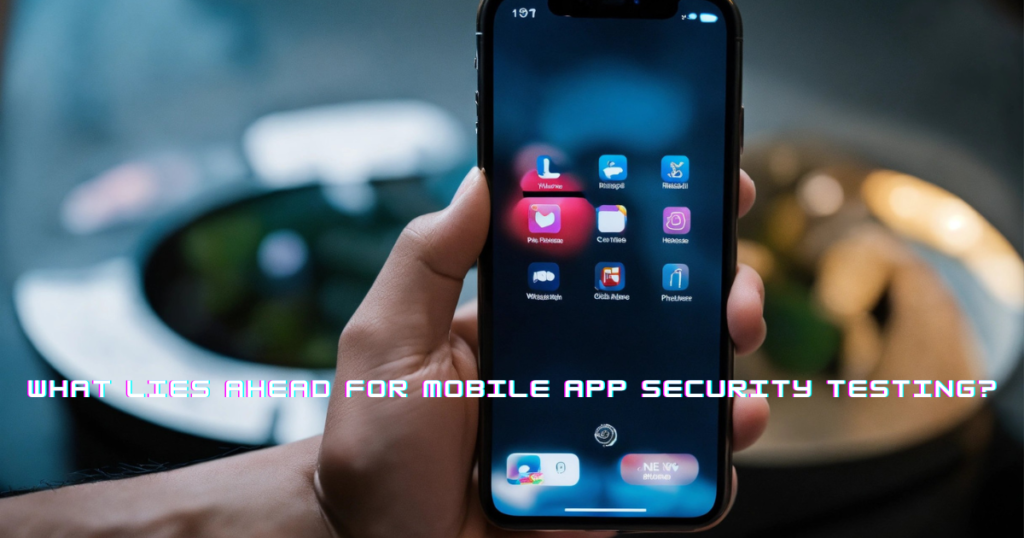Introduction
The Mobile App Security Testing (MAST) market is undergoing significant transformations, fueled by the proliferation of mobile apps and the ever-evolving cybersecurity landscape. In this article, we explore the trends, challenges, and innovations that will shape the future of Mobile Application Security Testing (MAST).

Key Drivers: Mobile App Security Testing
- 1. Shift-Left Security Testing
- 2. Integration with DevSecOps
- 3. Leveraging Artificial Intelligence (AI) and Machine Learning (ML)
- 4. User Data Privacy and Regulatory Compliance
- 5. Bug Bounty Programs
- Market Projections: Mobile App Security Testing
- Challenges and Opportunities-Mobile App Security Testing
- What are the challenges specific to Android security testing?
- Conclusion-Mobile App Security Testing
- FAQs and Answer: Mobile App Security Testing
- Disclaimer
1. Shift-Left Security Testing
As organizations embrace agile methodologies, security testing is moving leftward in the software development lifecycle. The Developers actively participate in identifying and addressing security vulnerabilities early on. This approach ensures that security becomes an integral part of the development process, minimizing the risk of post-release security gaps.
2. Integration with DevSecOps
DevSecOps, the convergence of development, security, and operations, emphasizes continuous security throughout the software pipeline. MAST tools seamlessly integrate into DevSecOps workflows, enabling real-time vulnerability assessments and prompt remediation.
3. Leveraging Artificial Intelligence (AI) and Machine Learning (ML)
AI and ML are revolutionizing security testing. These technologies enhance vulnerability detection accuracy, automate repetitive tasks, and provide actionable insights. Expect MAST solutions to leverage AI/ML for smarter threat identification and risk mitigation.
4. User Data Privacy and Regulatory Compliance
Heightened awareness of user data privacy and stringent regulations (such as GDPR) drives the demand for robust security testing. Organizations must safeguard sensitive user information, making MAST an essential component of compliance strategies.
5. Bug Bounty Programs
Bug bounty programs incentivize ethical hackers to discover vulnerabilities in applications. MAST tools play a crucial role in identifying and fixing these vulnerabilities before malicious actors exploit them.
Market Projections: Mobile App Security Testing
The global MAST market is poised for exponential growth:
- Current Worth: In 2023, the MAST market is estimated to be worth USD 0.9 billion.
- Projected Value: By 2028, it is expected to reach USD 3.2 billion at an impressive CAGR of 28.3%.
Challenges and Opportunities-Mobile App Security Testing
1. Continuous Technological Advancements
Mobile platforms, operating systems, and development frameworks evolve rapidly. Frequent software updates introduce new features, APIs, and security protocols. However, they can also inadvertently introduce vulnerabilities. Organizations must adapt their security testing strategies to keep pace with these changes.
2. Platform-Specific Testing
iOS and Android dominate the mobile landscape. While Android faces a diverse ecosystem, iOS maintains a controlled environment. MAST solutions must cater to both platforms, with a focus on the iOS segment, which is expected to exhibit the highest growth rate.
3. Cloud Deployment: Mobile App Security Testing
Cloud-based MAST solutions offer scalability and flexibility. Organizations will increasingly adopt cloud deployment models, necessitating robust security testing for cloud-native applications.
4. Threat Intelligence Integration
MAST tools should integrate threat intelligence feeds to proactively identify emerging threats. Real-time threat data enhances vulnerability assessments and strengthens security postures.
What are the challenges specific to Android security testing?
Android security testing presents several unique challenges due to the platform’s diverse ecosystem and dynamic nature. Let’s explore these obstacles:

Fragmented Ecosystem: Mobile App Security Testing
- Variety of Devices: Android runs on thousands of different devices from various manufacturers, each with its own hardware specifications. Vulnerabilities present in one device might not exist in another.
- Multiple OS Versions: No all devices run the latest Android version. Older versions may contain vulnerabilities that have been patched in newer ones.
- Overcoming the Challenge: Prioritize testing based on user base analytics. Focus efforts on the devices and OS versions most commonly used by your audience.
Dynamic Code Execution:
- Many Android apps use techniques like Just-In-Time (JIT) compilation, which changes the app’s behavior at runtime. This dynamic nature makes static analysis challenging.
- Overcoming the Challenge: Combine the static analysis with dynamic analysis. Tools like Frida allow you to hook into running processes and examine real-time application behavior.
Obfuscated Code: Mobile App Security Testing
- Developers often obfuscate their code to protect intellectual property and hinder reverse engineering. Analyzing obfuscated bytecode is more difficult.
- Overcoming the Challenge: Utilize de-obfuscation tools like JADX or JEB to decompile obfuscated code, making it more readable for testers.
App Sandbox Environment:
- Android’s security model isolates each app in its own user sandbox, limiting interactions with other apps and the system. While this enhances security, it complicates understanding app interactions and data sharing.
- Overcoming the Challenge: Focus on inter-process communication mechanisms (e.g., content providers, intents, and binders). Tools like Drozer assist in exploring and exploiting these avenues.
Emerging Technologies: Mobile App Security Testing
- Technologies like Instant Apps (which run without installation) and Progressive Web Apps blur the lines between websites and apps. Traditional testing methodologies may not always apply.
- Overcoming the Challenge: Stay updated with the latest in Android development to adapt testing strategies.
Conclusion-Mobile App Security Testing
The future of Mobile App Security Testing (MAST)lies in proactive security measures, AI-driven testing, and collaboration across development and security teams. As mobile applications become more intricate, robust security testing will be non-negotiable. Organizations that invest in MAST today will safeguard their digital assets and user trust tomorrow. Android security testing requires a holistic approach that considers device diversity, code obfuscation, dynamic behavior, sandboxed environments, and emerging trends. Staying informed and using a combination of techniques will help address these challenges effectively.
FAQs and Answer: Mobile App Security Testing
How do I test my mobile apps for security?
- To ensure the security of your mobile apps, consider a comprehensive approach. Implement static and dynamic analysis techniques, perform penetration testing, and leverage automated tools tailored for mobile application security testing. Regularly update and patch your app, conduct code reviews, and involve ethical hackers through bug bounty programs to identify and address vulnerabilities proactively.
What are the things to consider testing a mobile application?
- When testing a mobile application, focus on key aspects such as data encryption, secure authentication mechanisms, authorization controls, secure data storage, network security, and secure communication channels. Additionally, evaluate the app’s resistance to common threats like injection attacks, session management vulnerabilities, and insecure data transmission. Regularly update and patch the application to address emerging security concerns.
How do I ensure mobile app security?
- Ensuring mobile app security requires a multifaceted approach. Begin by incorporating security practices throughout the development lifecycle, embracing the principles of DevSecOps. Regularly update and patch your app, conduct thorough security testing, implement strong authentication and authorization controls, encrypt sensitive data, and stay informed about the latest security threats and best practices. Engage in ongoing monitoring and employ robust incident response plans to address security incidents promptly.
What would be the most important factors to you when it comes to mobile app security?
- The most critical factors in mobile app security include:
- Data Encryption: Ensure sensitive data is encrypted both in transit and at rest.
- Authentication and Authorization Controls: Implement strong authentication mechanisms and proper authorization controls.
- Regular Updates and Patching: Keep the app up-to-date with the latest security patches to address vulnerabilities.
- Security Testing: Regularly conduct comprehensive security testing, including static and dynamic analysis.
- User Education: Educate users on security best practices to mitigate social engineering and phishing attacks.
- Incident Response: Have a well-defined incident response plan to address security incidents promptly.
- Compliance: Adhere to relevant data privacy regulations and industry security standards.
- By prioritizing these factors, you can establish a robust security posture for your mobile applications, protecting both user data and the integrity of the app.
Disclaimer
This article relies on internal data, publicly available information, and other reliable sources. It may also include the authors’ personal views. However, it’s essential to note that the information is for general, educational, and awareness purposes only—it doesn’t disclose every material fact.
We publish information on World Virtual CFO in good faith, solely for general information. World Virtual CFO doesn’t guarantee the completeness, reliability, or accuracy of this information. These are our views for informational purposes. When you use our website, know that any action you take is entirely at your own risk. World Virtual CFO won’t be liable for any losses or damages connected to your use of our website. For detailed information, refer to our disclaimer page.
Dr. Dinesh Sharma is an award-winning CFO and AI strategist with over two decades of experience in financial leadership, digital transformation, and business optimization. As the founder of multiple niche platforms—including WorldVirtualCFO.com—he empowers professionals and organizations with strategic insights, system structuring, and innovative tools for sustainable growth. His blogs and e-books blend precision with vision, making complex financial and technological concepts accessible and actionable.